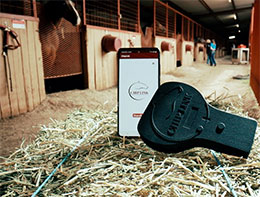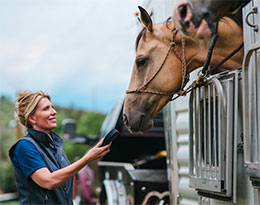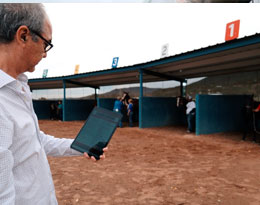- News
- Horse Racing
- Racing Preview
- AQHA Racing Challenge
- Breeding
- Sales
- Quick Stakes Results
- Detail Race Results
- Qualifiers
- Leader Board
- Leading Sires
- Videos
- Auction Leaders
- Q-Racing
Streaming Video
© Courtesy Lip Chip

Sponsored Content from Lip Chip
SAN ANGELO, TX—OCTOBER 14, 2021—Six. The average racehorse must be identified no less than six times in order to safely enter, work, and run at tracks across America.
Horses are identified when they arrive in the trailer, when a veterinarian administers treatment, and when they are taken to the track for a work. When they run, horses are identified at the holding barn, again in the paddock, and finally they are identified again at the test barn.
Six occasions in which not being able to tell one bay with no markings apart from another could be dangerous. Six occasions where racetracks and their regulatory bodies must ask themselves, can we truly know one horse from another? One company, Lip Chip LLC, decided it is time to stop guessing.
Lip Chip LLC offers a new way to identify horses and solve issues that have been plaguing the equine industry for decades. The company’s Chip Link System uses microchipping and a state-of-the-art handheld reader to go beyond just your average identification. Most microchipping technology simply reads the chip’s 15-digit identifier, and nothing more. The Chip Link System uses a Bluetooth reader to send that unique identifier to a smart phone, tablet or PC, which unlocks secure data linked to each horse as their microchip is scanned. The user can identify each horse within seconds, and view current coggins, owner information, emergency contact numbers, and even recent photos of each horse. Instead of relying on hard copy paperwork, horsemen can identify horses and view their data from a secure location. No more forged documents or similar horses being swapped. Microchipping unlocks a new level of security.
Lip Chip offers not only superior technology but also superior placement for horse owners and trainers who are tired of the issues with the traditional method. Currently, microchips are placed in the nuchal ligament. However, these microchips are shown to migrate up to 30% if not properly injected. Lip Chip offers a new placement in the upper mandible, which goes into the top lip of the horse. This placement has seen less than 1% migration. It also provides unobstructed access to the microchip, as most horses are more likely to bump a foreign object with their nose versus their neck. Identifiers can reach the chip much easier in the trailer and at the paddock, and scanning is a safer and quicker process.

“Honestly, I had heard people talk about the issues they were seeing every day, and no one ever did anything about it,” said Bolen. “You would have an entire racetrack get shut down because of an equine herpes outbreak, or have a horse get scratched because they couldn’t find his microchip or read his tattoo. And I knew it was time to find a way to solve these issues and make life easier on our industry.”
All equine disciplines across the board can benefit from the Chip Link System. All horsemen face the same issue of keeping up with hard copy paperwork for each horse. In order to compete in any show, rodeo, or race these equine athletes are held to a higher standard to ensure disease and cheating does not occur. The ability to scan the horse and retrieve this information is a game changer and adds a new level of transparency to equine performance.

Lip Chip was built by horsemen, for horsemen, to bring integrity and transparency back to the industry. The Chip Link System offers a way to move past just an identification and make each microchip a secure key for horses and their handlers. It is time for technology to stop being the enemy of the horseman and instead become his saddle partner. It is time to let the innovations of today help the issues that have plagued our industry for generations. The future of equine microchipping is here, and the future is Lip Chip.
CLICK HERE to watch a YouTube video on Lip Chip.
Reprinted courtesy PaulickReport.com

 Newsletters
Newsletters Facebook
Facebook